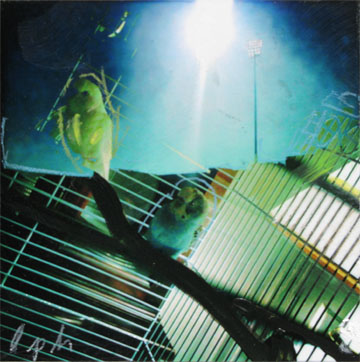
Lincoln Hancock, "A Bird, Not A Feather," mixed media, 2010. Courtesy the artist.
In a lecture delivered at Harvard in 1985 (posthumously published in Six Memos for the Next Millenium), Italo Calvino describes lightness as expressive of a certain kind of possibility in face of “the weight, the inertia, the opacity of the world.” Calvino’s talks at the Charles Eliot Norton lectures were centered on literary values, but painting — indeed, the entirety of the art experience — has always been about this for me. In art, I look for a space outside of the enumerable into which to leap.
This urge is pervasive. Art is a practice that informs life, and provides ways to elude Medusa’s gaze. Calvino takes the myth as poetic allegory: “Perseus’s strength always lies in a refusal to look directly, but not in a refusal of the reality in which he is fated to live; he carries the reality with him and accepts it as his particular burden.” So, to fly up and out of the panopticon of fixed meaning and moral surveillance is not a wanton act. It is a creative, meaningful gesture enabled precisely by an acknowledgement of its situatedness and necessary relationship to the world. As Calvino indicates, lightness entails looking at the world “from a different perspective, with a different logic and with fresh methods of cognition and verification.”
I’d read and loved Invisible Cities and If on a winter’s night a traveler, but only learned of Six Memos earlier this year — Elliott Earls mentioned the book in a piece in Emigre No. 35. (I was looking back over some of Earls’s writing, as my colleague Dan McCafferty and I had invited him to NC State for our graduate symposium on Design, Community, and the Rhetoric of Authenticity.) Calvino posits lightness, quickness, exactitude, visibility, and multiplicity as five characteristics of an art that might hold within itself room for the future. (Esther Calvino notes that Italo wanted to title the sixth lecture “Consistency.”)
This summer, as I assembled work for my second solo exhibition, I returned to Calvino’s notion of lightness. In many ways it represents the attitude I feel challenged to cultivate in my own practice. And in terms of an explicit theme, the images I created repeatedly referenced places and experiences that stand for me as exemplars of interpretive possibility. Lightness is not about fancy so much as a meaningful embrace of the distance inherent in conscious experience. We live in the world, yet we are always already free to make it anew through our creative practices.
So, my nonrepresentational paintings are never indicative of a wish to abandon the incumbencies of the world. They are, rather, precisely, paeans to the possibility of the here and now — a contextual possibility and potency too often neglected by conventions of being and seeing. For if there is a chance to find resonance and meaning in simple structures of color and line, our position as empowered, creative, agents is reasserted. These paintings are spaces and monuments that sanction things not quantifiable, indexible, mechanically apprehensible. These moments help us transcend, and remind us that things mean for us — not the other way around.
My recent pictorial mixed-media work (such as the series of “doubles” in this recent show] draws on my ongoing photographic practice, which is itself informed by the same values. The improvisatory process of taking pictures helps me come away with impressions of my lived experience that avoid being weighed down by the prefab fixities of existing systems of meaning. I shoot in ways that privilege spontaneity over perfection, because yielding to “the way things are supposed to look” already forecloses on the possibility of potent new awareness.
Calvin Tomkins writes in the Preface to his recent Lives of the Artists, that contemporary art practice is often “…among other things, an approach to the problem of living.” Problem, weight, opacity — from a certain perspective these words sound like detractors. But lightness is an expressive center that leverages our intentional relationships with the substantial qualities of the world into a radical remaking — as Calvino alludes, it is a “balance of forces that enables heavenly bodies to float in space.”



